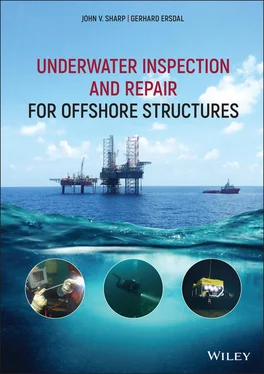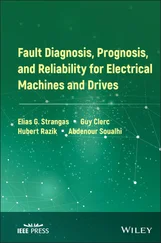close visual examination of all chain links, with cleaning if required;
enhanced NDE sampling of:5% of the chain20% of chain which has been in the proximity of fairleads in the last 5 yearsall connecting links
dimensional checks, including lengths over five links;
checking looseness and pin‐securing arrangements of joining shackles;
measurement of thickness (diameter) of approximately 1% of all chain links distributed through the working length of the chain; and
dismantling and MPI of all Kenter‐type shackles which have been in service for more than 4 years.
2.5 Standards and Guidance Notes for Concrete Structures
2.5.1 Introduction
The international recognised standard for designing, fabricating and maintaining offshore concrete structures is the ISO 19903 (ISO 2019b), originally introduced in 2006 and updated in 2019. The ISO standard was based on the Norwegian standard NS 3473 with input from other relevant standards. Previously, the Department of Energy introduced a set of Guidance Notes for offshore concrete structures in 1974 which was significantly updated in the fourth edition, published in 1990 (Department of Energy 1990) and supported by a background document on concrete (HSE 1997). The emphasis of these documents, however, was on design and construction of offshore concrete structures with limited sections dealing with inspection and repair. In addition, the Norwegian standard NORSOK N‐005 (Standard Norge 2017b) has some international status. NORSOK N‐005 includes a special annexe covering inspection of concrete structures. The relevant sections of ISO 19903, the Department of Energy Guidance Notes and NORSOK N‐005 are discussed below.
2.5.2 ISO 19903—Concrete Structures
ISO 19903 (ISO 2019b) includes an inspection programme for concrete structures similar to that in, for example, ISO 19902 for steel structures, requiring an initial (baseline), periodic and special inspection to be performed. The initial inspection is required as soon as possible after installation to verify the original design and that all the major parts of the installed structure have no obvious defects. Following this initial inspection, inspection and condition monitoring of the structure shall be carried out regularly in accordance with the established programme. Special inspections should be conducted after direct exposure to an accidental or design environmental event (wave, earthquake, etc.). These inspections should encompass the critical areas of the structure. However, following an accidental event such as a boat collision and a dropped object, the inspection may, in certain circumstances, be limited to the local area of damage. In addition, the standard requires that measures should be taken to maintain the structural integrity appropriate to the circumstances in an event such as change of use, life extension, major modifications and when inspection has revealed damage or deterioration.
Similar to the standards already discussed for steel structures, assessment of the condition of the structure should be carried out following the inspection activities. This assessment should include a summary evaluation being prepared at the end of each programme for inspection. It is also stated that the data gathered from each periodic inspection should be compared to data gathered from previous inspections, with the purpose of establishing any data trends that can indicate time‐dependent deterioration processes.
The typical inspection methods used for a concrete structure include:
GVI to detect obvious or extensive damage such as impact damage, wide cracks, settlements and tilting. Prior cleaning of the inspection item is not needed for this type of inspection.
CVI to detect less extensive damage. CVI requires direct access to the inspected area and prior cleaning of the item to be inspected is normally needed.
Non‐destructive testing involves close inspection by electrical, electrochemical or other methods to detect hidden damage such as delamination. Prior cleaning of the inspection item is normally required.
Destructive testing such as core drilling which is used to detect hidden damage or to assess the mechanical strength or parameters influencing concrete durability.
In the standard, structural monitoring methods are proposed to be used in areas with limited accessibility or for monitoring of, for example, action effects and corrosion development. The sensors needed for this monitoring, such as strain gauges, pressure sensors, accelerometers, corrosion probes should preferably have been fitted during construction.
The structure may also have been instrumented in order to record data relevant to pore pressure, earth pressure, settlements, subsidence, dynamic motions, strain, inclination and possibly temperature in oil storage. These monitoring systems are required by the standard to be tested and inspected regularly.
Required locations for inspection on a concrete structure include a survey of the atmospheric zone, the splash and the tidal zones and the important areas of immersed concrete. It is generally recognised that the splash zone is most vulnerable to corrosion. To determine the extent and frequency of inspection for different structural parts it is recommended that the exposure or vulnerability to damage is considered. ISO 19903 (ISO 2019b) states that the inspection of the internal parts of the structure (e.g. inside the legs) should focus on:
detecting any leakage;
biological activity;
temperature, composition of sea water and pH values in connection with oil storage;
detecting any corrosion of reinforcement; and
concrete cracking.
Special areas for inspection:
Splash zone; it can experience damage from impact of supply vessels and is also sensitive to corrosion of the reinforcement. It can also deteriorate from ice formation with ensuing spalling in surface cavities where concrete has been poorly compacted. Ice abrasion and freeze‐thaw cycling can also lead to early deterioration even with high quality concrete. This deterioration can lead to subsequent loss of cover over the reinforcement steel leading to potential steel corrosion. ISO 19903 (ISO 2019b) recommends that repairs to these damaged surfaces should be made as soon as possible to prevent further deterioration and structural overload.
Construction joints in the concrete structure; these represent potential structural discontinuities where water leakage and corrosion of reinforcement are possible negative effects. As a minimum, the monitoring programme should identify construction joints located in high stress areas and monitor the performance with respect to evidence of leakage, corrosion staining or local spalling at joint faces (which indicates relative movement at the joint). In addition, evidence of poorly placed and compacted concrete, such as aggregate pockets and delaminations and joint cracking or separation, are areas for investigation.
Embedment plates; these may create a path for galvanic corrosion to the underlying steel reinforcement. The main concerns are corrosion and spalling around the plates. Galvanic corrosion is a serious possibility where dissimilar metals are in a marine environment and could lead to deterioration of the reinforcing steel, which is in contact with the embedment plates.
Repair areas and areas of inferior construction; ISO 19903 (ISO 2019b) states that concern is associated with areas that provide a permeable path through which a flow of seawater can take place as the continuous flow of saline and oxygenated water can cause corrosion of the reinforcement. In addition, attention is recommended to be given to the surface and the perimeter of patched areas for evidence of shrinkage cracking and loss of bond to the parent concrete surface.
Читать дальше












